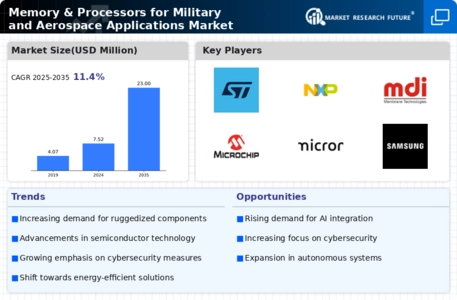By Region, the study provides market insights into North America, Europe, Asia-Pacific, Middle East and Africa and South America. The North America region's market is expanding significantly, The Asia pacific Memory & Processors for Military and Aerospace Applications market accounted for ~37.69% in 2023. North America increases investments in cutting-edge technology, driving innovation and advancement in military and aerospace systems. The same concept is highly illustrated through major aerospace and defense trade shows organized in the region, which provide crucial platforms for displaying high-quality military and aerospace-specific memory and processing technologies.
Moreover, the increasing application of drone technology in US military operations indicates a trend toward higher-speed RAM and microprocessors to support the power requirements of unmanned aerial systems (UAS). North America is an attractive market for suppliers and manufacturers of memory and processors due to huge funds aimed at upgrading military infrastructure. Thus, it is worth noting that such sectors cater mainly to applications in the military and aerospace.
This region is highly determined to address major challenges such as operational efficiency, system reliability, security measures, among others, which has helped it spearhead in technological advancements impacting future military and aerospace systems worldwide.
FIGURE 3: MEMORY & PROCESSORS FOR MILITARY AND AEROSPACE APPLICATIONS MARKET SIZE BY REGION 2023 VS 2032 (USD Million)

Source: Secondary Research, Primary Research, MRFR Database, and Analyst Review
Further, the major countries studied in the market report are the U.S., Canada, Germany, UK, France, Spain, Italy, China, India, Japan, Australia, and South Korea.
The memory and processor market for military and aerospace uses has a considerable share in Europe due to its sturdy aerospace sector. European businesses are innovative and technologically driven, hence they dominate the development as well as manufacturing of civil and military aircraft, helicopters, drones, aero-engines, systems, and equipment. Among other sectors in Europe’s aerospace defense ecosystem is civil aeronautics, which contributes most significantly to yearly turnover and job generation.
Despite facing challenges such as lower airplane production rates caused by the COVID-19 pandemic, the European aviation industry can be regarded as resilient owing to their determination towards innovation and sustainability.
The Asia-Pacific region is witnessing a rapid expansion in its space industry, driving the demand for robust memory and processor solutions tailored to military and aerospace applications. the emergence of small, private commercial space startups in China and Japan, inspired by successful ventures like SpaceX in the U.S., adds dynamism to the industry. While these startups may not match the scale of SpaceX yet, their innovative approaches signal the potential for significant contributions to the sector in the near future.
The evolution of government space programs is experiencing a paradigm shift where the main thrust is directed towards natural resource exploration. Programs such as China’s lunar program and Japan’s Artemis participation demonstrate the increased interest in resource extraction from celestial bodies such as the Moon and asteroids. The recent attempt by Japan to land a spacecraft on the lunar surface and Chandrayaan-3, successfully launched by India, are prominent among other space missions originating from this region showcasing their ambitious space exploration journeys.


















Leave a Comment